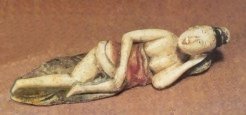|
變異的性行為
|
|
兩種變異的性行為舉例: 1.
戀物癖 |
|
歷史的佐證- 纏足
1 |
 |
|
中國微型色情雕塑
該翡翠雕像可以追溯到15世紀,非常清楚地顯示了由纏足習俗所形成的這種小而尖的“三寸金蓮”。蒙中國古代性文化博物館(江蘇吳江市同裏鎮)惠允。 |
|
Chinese erotic statuette
The jade sculpture, dating from the 15th century A.D., very clearly shows the small, pointed feet produced by the practice of foot binding.
Courtesy China Sex Museum, Tongli |
|
一度風行在中國、現在已經廢止的女人纏足風俗給我們提供了一個令人感興趣的佐證:從孩童早期開始,小女孩的雙腳就用纏腳布裹得緊緊的,以防止雙腳的自然生長。這種痛苦的纏足程式要堅持數年,直到最終形成成年女性的那種具有代表性的畸形“三寸金蓮”。
據文獻報導,纏足風俗初起宋朝(西元960-1279),起源于達官顯貴階層,歷經數個世紀,也被中下階層所仿效。因而,從相對罕見的一種現象開始,最終變成了事實上幾乎遍及中國每一個女孩的一種風俗。在清朝(1636-1911),纏足變得如此之廣泛和如此之亦步亦趨,以至於絕大多數中國婦女被殘害成幾乎不能行走的小腳女人。最後,1000多年之後,隨著1911年清王朝的終結和第一個共和政府的誕生,這種野蠻的習俗才被廢止。
纏足的理由可以概括如下: |
違背自然規律的纏足是
-
①
社會地位的象徵
達官顯貴婦人的“三寸金蓮”表明了她們高傲的社會地位和不必工作的客觀事實。
-
②
受壓迫的標誌
有“三寸金蓮”的女人不能走得太遠,因而用來防止她們“逃跑”。所以,她們依賴家庭和被限制在家庭這個小圈子。這也保證了她們服從丈夫的統治。
-
③
性欲的對象
女性的“三寸金蓮”被認為有性吸引力和增加了女孩在婚姻市場的徵婚機會。甚至,許多女孩被賣作新娘或高價賣給富裕男人作小妾。
|
|
|
上述的最後一個理由是性學家感興趣的,因為它似乎表明中國社會的男人普遍的戀足癖現象,這似乎也是文化培育的結果。 |
|
Variations in Sexual Behavior |
|
Two Examples: 1. Fetishism
|
|
A Historical Case in Point - Foot Binding |
|
An interesting case in point is presented by the once popular, now abandoned Chinese custom of binding female feet: Beginning in early childhood, a girl’s feet were wrapped in very tight bandages, preventing their normal growth. This painful procedure was continued for years and eventually resulted in the typical, deformed, very small feet of adult Chinese women.
First reported as an already existing practice in the Song Dynasty (960-1279 A. D.), it originated with the upper classes and, over the centuries, was also adopted by the middle and lower classes. Thus, from a relatively rare phenomenon, it eventually turned into a nearly universal custom affecting virtually every young girl in China. In the Qing Dynasty (1636-1911), footbinding became so widespread and was so strictly executed that the vast majority of Chinese women were turned into cripples who could hardly walk. Finally, after more than 1000 years, with the end of the monarchy and the arrival of the first republican government in 1911, the practice was banned as barbaric.
The reasons for footbinding can be summarized this way:
|
|
Unnaturally small female feet were
1.
A status symbol
The crippled feet of aristocratic ladies demonstrated their high social rank and the fact that they did not have to work.
2.
A mark of oppression
Women with crippled feet could not walk very far and thus were prevented from “running away”. Instead, they were tied to the household and restricted to the domestic sphere. This also ensured their obedience to their husbands.
3.
Objects of sexual desire
Female crippled feet were considered erotically attractive and increased a girl’s chances in the marriage market. Indeed, many girls were sold as brides or concubines to rich men who paid handsome sums to their parents.
|
|
|
The last point is interesting for sexologists, because it seems to indicate some culturally nurtured, widespread male foot fetishism.
|